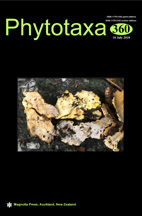Abstract
The dead plant material (canopy organic matter) associated with the mats of vascular plants and bryophytes found on tree branches in temperate rainforests along the southwestern coast of New Zealand was investigated for the presence of myxomycetes (plasmodial slime molds or myxogastrids). Samples of both the superficial litter layer (canopy litter) on the surface of the mat and the humus-like layer (canopy soil) beneath the mat were collected and used to prepare a series of moist chamber cultures. Canopy soil yielded more positive cultures (57%) but only three species of myxomycetes, whereas eight species were recovered from canopy litter (40% positive cultures). The higher percentage of positive cultures for canopy soil was the result of the appearance of plasmodia that could not be induced to form fruiting bodies. In contrast, fruiting bodies represented 67% of the positive cultures recorded from canopy litter.

